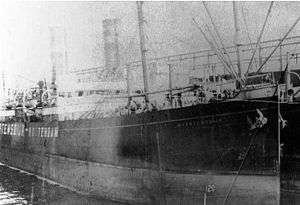USS Maartensdijk (ID-2497)
 Maartensdijk (Dutch Cargo Ship, 1902) photographed prior to her U.S. Navy service. | |
| History | |
|---|---|
| Name: | USS Maartensdijk |
| Namesake: | A merchant name retained |
| Owner: | Holland-American Line, Rotterdam, Netherlands |
| Builder: | Furness Withy and Co., Ltd., West Hartlepool, Great Britain |
| Laid down: | date unknown |
| Christened: | as Rapallo |
| Completed: | in 1902 |
| Acquired: | by the Navy 21 March 1918 |
| Commissioned: | 28 March 1918 as USS Maartensdijk (ID # 2497) |
| Decommissioned: | 25 February 1919 |
| Struck: | February 1919 |
| Captured: | seized by U.S. Customs at New York City 20 March 1918 |
| Fate: | transferred to the U.S. Shipping Board 25 February 1919; then returned to her owner, Holland American Line |
| General characteristics | |
| Type: | Freighter |
| Displacement: | 13,000 tons |
| Length: | 400' 6" |
| Beam: | 52' 1" |
| Draft: | 28' 6" |
| Speed: | 11 knots |
| Complement: | 113 officers and enlisted |
| Armament: |
|
USS Maartensdijk (ID-2497) was a freighter seized by U.S. Customs when the United States declared war against Germany in World War I. Maartensdijk – a Dutch-owned vessel—was used by the Navy to transport military cargo across the Atlantic Ocean in support of Allied troops in Europe.
Seized by U.S. Customs
Maartensdijk, a steel cargo steamer, was built as Rapallo by Furness Withy & Co., Ltd., West Hartlepool, England, in 1902. Prior to World War I, she sailed the Atlantic sealanes and in 1918 was owned by Holland-American Line, Rotterdam, Netherlands. Maartensdijk was seized by U.S. Customs at New York City 20 March 1918; turned over to the Navy 21 March; and commissioned 28 March for duty with NOTS.
World War I service
After loading Army cargo, Maartensdijk departed in convoy for European waters 10 April. Steaming via Halifax, Nova Scotia, she reached St. Nazaire, France, 14 May, discharged her cargo, and sailed for the United States 15 June. During the closing months of World War I she made two more cargo runs out of New York and Boston, Massachusetts, to French ports.
Post-war service
She returned to New York City 2 days after the signing of the Armistice. Sailing from Boston 12 December, she carried additional cargo to French ports and returned Army supplies to the United States. In all, she transported more than 27,000 tons of supplies during her four cargo runs to France.
Post-war decommissioning
Maartensdijk returned to New York City 9 February 1919. She decommissioned there 25 February 1919; transferred to the U.S. Shipping Board the same day; and subsequently was returned to her owner, Holland American Line.
See also
- United States Navy
- World War I
- This article incorporates text from the public domain Dictionary of American Naval Fighting Ships. The entry can be found here.
- Maartensdijk (Dutch Freighter, 1902); Later USS Maartensdijk (ID # 2497), 1918-1919